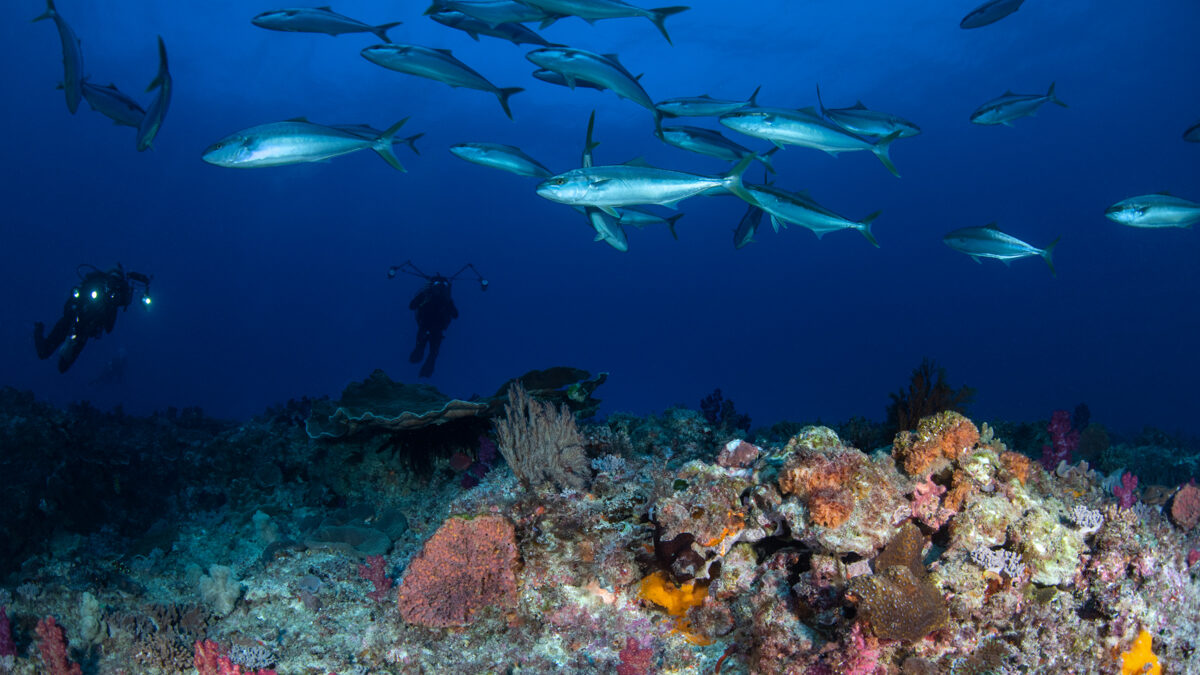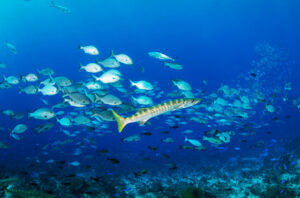by Kristen Goodhue

Three thousand reefs. (Technically 3,040 reefs, for those who like precision.) That’s how many underwater sites scientists and volunteers poured over in the latest effort to uncover how much biodiversity matters for reef health.
The answer: Quite a lot.
Scientists have known for years that diverse fish communities help ocean ecosystems flourish, even when facing rising temperatures and climate change. But the latest study, published in Nature Communications, reveals it’s about more than the numbers. Which species call a reef home can matter just as much as how many there are. And that holds especially true when it comes to large predator fish.
“It’s like your stock market portfolio. It’s important to have a diversity of investments to protect yourself from any one stock losing its value. But it never hurts to have a few heavy hitters, like Apple or Microsoft,” said lead author Jonathan Lefcheck, a research ecologist with the Smithsonian Environmental Research Center and the Tennenbaum Coordinating Scientist for the Marine Global Earth Observatory Network. “Fish communities benefit from having more species in them, but also a handful of large species that contribute disproportionately to the total ‘wealth’ of the community.”
Lefcheck and his coauthors relied on a global database called Reef Life Survey for the new paper. Reef Life Survey is a nonprofit, citizen science program where trained SCUBA divers do censuses of reefs worldwide. It’s led by Rick Stuart-Smith and Graham Edgar of the University of Tasmania, also coauthors of the new study. To date, the program has gathered biodiversity data from nearly 4,000 reefs.
The reefs the team used for this study ranged from the rocky shores of British Columbia in the north to the tip of Tierra del Fuego by the South Pole.

To tease out the impact of biodiversity from other factors, the biologists used a compare-contrast method. First, they chose 173 “reference reefs”—reefs that were healthy, with thriving fish populations. They chose reefs with the highest fish biomass for comparison because managers often seek to maximize fish mass on reefs, to keep reefs healthy and provide stock for fisheries. Then, they compared each reference reef to all its nearby reefs in the database—reefs no more than 100 kilometers away. Each reference reef had about 16 “comparison reefs” on average, though a few had over 100. When doing the comparisons, they adapted something called the “Price equation,” originally devised for evolutionary biology in the 1970s. They used total fish biomass (the mass of all fish on a reef, regardless of species) to indicate how healthy a reef was compared to its neighbors, and its potential value to people.
They discovered biodiversity had nearly six times more impact on fish biomass at the healthiest reefs than other influences, like temperature, pollution and water clarity.
But the story took a more surprising turn when they investigated what type of biodiversity was important. A high number of species alone wasn’t enough to explain biodiversity’s outsized impact. The team also looked at which species neighboring reefs were losing, or gaining, compared to their reference reefs.
Losing big species, it turned out, was nearly four times more harmful than a drop in the number of species. Larger fish, like sharks and groupers, are especially vital for making their habitats tick. When the authors looked for species in the thriving “reference reefs” that were absent in neighboring reefs, the biggest fish over 6.5 feet long accounted for over half that biomass.
Unfortunately, large fish are often among the first to disappear. Fishing disproportionately removes the biggest swimmers, something multiple studies and local indigenous knowledge have shown.
The ultimate solution, however, could allow both reefs and fishing communities to prosper. Marine protected areas have proven their worth many times over. Fish grow larger and more abundant in protected zones. And since marine life spreads, protected zones often increase the catch for fishers outside those areas as well.
To get the biggest value for restoration, this study suggests one slight modification: Add protection strategies that target high performers, like sharks and groupers. When top predators flourish, the effects often cascade down to help the entire reef ecosystem and the people it sustains.
“Big fish tend to need big territories, and many travel long distances to specific breeding spots,” said Emmett Duffy, director of the Marine Global Earth Observatory Network. “Protecting them requires a network of reserves strategically placed so they can safely roam.”
The study, “Species richness and identity both determine the biomass of global reef fish communities,” is available on the Nature Communications website at https://www.nature.com/articles/s41467-021-27212-9.

